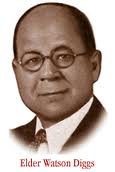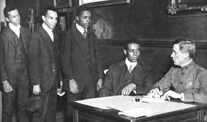Who was Elder Watson Diggs?
George Hicks, III and Carmon Weaver Hicks, Ph.D.
July 2011
 Elder Watson Diggs was born on December 23, 1883 in Hopkinsville, KY. He was raised in Madisonville, KY and was the eldest son of Cornelia Diggs. He had one brother, Ellis, and one sister, Essie (www.42.ips.k12.in.us, 2011).
Elder Watson Diggs was born on December 23, 1883 in Hopkinsville, KY. He was raised in Madisonville, KY and was the eldest son of Cornelia Diggs. He had one brother, Ellis, and one sister, Essie (www.42.ips.k12.in.us, 2011).
He graduated from Indiana Normal School (Indiana State Teachers College in Terre Haute) in 1908 then, attended Howard University in 1909 where he met Byron K. Armstrong. In 1909, he and Armstrong transferred to Indiana University where they were among the only 10 students enrolled (http:/en.wikipedia.org/wiki/Elder Watson Diggs, 2011). African American students were not allowed to live on campus and could not participate in activities, such as using recreational and entertainment facilities, with white students. He took a room in a boarding house in Bloomington run by an African American woman.
Unhappy with campus life, Diggs wanted to establish a fraternity on campus to give African American students support and sanctuary. On January 5, 1911, he and nine other men formed Kappa Alpha Psi fraternity at Indiana University. Their purpose was to raise the sights of black students to stimulate their accomplishments to a higher level than anyone expected. In June 1912, Diggs, Armstrong, and others continued to develop aspects of the fraternity while working as waiters in Ft. Wayne, IN. Diggs completed the fraternity’s constitution and initiation ceremony, and with the help of others, completed the coat of arms. (http://en.wikipedia.org, 2011). He served as a Grand Polemarch (president) from 1911-1917 and traveled around the country to support newly formed chapters (www.42.ips.k12.in.us, 2011). Kappa Alpha Psi is the only national Greek letter organization with its Alpha Chapter at the Indiana University campus.
In the summer of 1912, he married his childhood sweetheart, Clara Bell Smith, in Lexington, KY. She was a public school teacher in Rising Sun, IN but their marriage was a secret since married women were not allowed to serve as teachers or educators (9 facts, 2011). His wife became seriously ill and Diggs withdrew from school to take care of her. In March 1913, she died but he continued his work expanding fraternities at other universities (http://en.wikipedia, 2011).
In 1916, Elder Diggs was the first African American to graduate from Indiana University’s School of Education. In the same year, he married Elizabeth Byrd and moved to Indianapolis where he began teaching in the public schools; he was quickly promoted to principal (http://en.wikipedia, 2011; www.42.ips.k12.in.us, 2011).
When World War I started, Diggs resigned from his principal position to enter the first Negro Officer’s Training camp at Fort Des Moines, IA. Thousands of black Americans enlisted but despite their eagerness to fight, the federal government limited their numbers. Groups like the NAACP pushed for black officer training but officials feared that the race issue would harm the war efforts. Eventually, a compromise was reached. One officer candidate school was opened for black college graduates and 1,000 black officers would be trained.
Fort Des Moines IA was the perfect location – it was isolated from major cities and was home to an abandoned cavalry post built in 1901 on 400 acres. The units that had served there left in 1916 for duty along the Mexican border.
The first black officer candidates arrived in May 1917 – all were college graduates and faculty from Howard, Tuskegee, Harvard and Yale. The student officers were put through weeks of intensive training under Col. C.C. Ballou, his staff, and a group of 250 non-commissioned officers (sergeants) from the 9th and 10th Cavalry and the 24th and25th Infantry (Buffalo Soldiers). Training was expected to last for 90 days but at the end of that period, the War Department added another month to their training (Scott, 1919).

On October 15, 1917, Diggs along with 638 captains and lieutenants (pictured at left) received their commissions (Morris, 2011). These 1,250 candidates were named the 17th Provisional Training Regiment. Of the 639 men, 106 were captains, 329 were first lieutenants, and 204 were second lieutenants. Diggs was a first lieutenant and was among many current and future leaders who achieved a variety of accomplishments. Frank Coleman and Edgar Love co-founded the Omega Psi Phi fraternity and cadet lawyers Samuel Joe Brown, Charles Howard, and James Morris co-founded the National Bar Association in 1925. The next day in equally divided groups, the officers were sent to the following camps – Camp Dodge, IA; Camp Grant, IL; Camp Sherman, OH; Camp Meade, MD; Camp Dix, NJ; and Camp Union, NY (Scott, 1919).
Elder Watson Diggs was assigned to Camp Sherman near Chillicothe, OH (Scott, 1919). The United States was not fully prepared for World War 1 so the government quickly created a system for training troops. Camp Sherman was one of the new training camps and soon became the third largest camp in the nation. By the end of World War 1, more than 40,000 soldiers trained there. It was organized like a small city. In addition to barracks and offices, there were theaters, a hospital, a library, a farm, and a German Prisoner of War camp. There was also a railroad system and the camp has its own utilities system (www.ohiohistorycentral.org, 2011).
In June 1918, Diggs and the other Fort Des Moines officers reunited in Hoboken, NJ for transportation to France and combat against Germany. They were the 3rd Battalion, 92nd Division of the American Expeditionary Forces. The 92nd Division consisted of the 183rd Infantry Brigade which included the 365th and 366th Infantry and the 184th Infantry Brigade which included the 367th and 368th Infantry. Elder W. Diggs was assigned to the 368th Infantry. These units fought bravely across France with the final battle at the French city of Metz where the Germans had built a fortress. For the first time, a black regiment under the command of black officers from Fort Des Moines led the attack in a major battle. The 92nd Division fought to within 800 yards of the German fortress when the bugle sounded announcing the end of the war (Morris, 2011).
Diggs continued his involvement with Kappa Alpha Psi and for his outstanding contributions and relentless efforts to improve and expand the fraternity, he was awarded the first Laurel Wreath in 1924 (Perry, 2011). This is the fraternity’s highest recognition of achievement. He also served as their Grand Historian from 1938-1939 (Fears, 2011).
Elder Diggs later served as a captain in the Reserve Officers’ Training Corp (ROTC). In 1936, he was instrumental in having the Indiana constitution amended to allow African American enlistment in the Indiana National Guard (www.in.gov/history/2416.htm, 2011; www.42.ips.k12.in.us, 2011).
After the war, he returned to his job as principal. In 1944, he earned his M.A. degree from Howard University (Fears, 2011).
Diggs died on November 7, 1947. After his death, the school where he served as teacher and principal for 26 years - Indianapolis Public School #42 - was named in his memory. He is buried in Crown Hill Cemetery in Indianapolis (section 98, lot 1121) (www.42.ips.k12.in.us, 2011; Perry, 2011). His widow, Lydia Diggs died less than 30 days after his death (http://en.wikipdeia, 2011).
References
9 facts about Elder Watson Diggs. (January 5, 2011).Retrieved on July 12, 2011 from
www.blackartblog.blackartdepot.com
Camp Sherman – Ohio history central. Retrieved July 12, 2011 from
http://www.ohiohistorycentral.org/entry.php?rec=670.
Elder W. Diggs, elementary school 42. Retrieved July 2, 2011 from
http://www.42.ips.k12.in.us/index.php?id=7512.
Elder Watson Diggs. Retrieved on July 13, 2011 from http:/en.wikipedia.org/wiki/Elder Watson
Diggs.
Fears, M. (July 1, 2011) Taking a look at the 10 founders of kappa alpha psi. Indianapolis
Recorder, p. 4.
IHB: Black soldiers in the war. Retrieved on July 13, 2011 from www.in.gov/history/2416.htm.
Morris, R.V. Black officers at Fort Des Moines in world war 1. Retrieved on July 12, 2011 from
http://www.iptv.org/iowapathways/mypath.cfm?ounid=ob_000294.
Perry, B.A. (July 1, 2011). Crown hill cemetery has 3 kappa founders. Indianapolis Recorder, p. 7.
Photograph of Elder Watson Diggs. Retrieved on July 12, 2011 from
www.imageselderwatsondiggs.
Photograph of commissioned officers at Fort Des Moines. Retrieved on July 13, 2011 from
www.aregistry.org/historic_events/view/first-black-officers-finish-military-duty.
Scott, E.J. (1919). Scott’s official history of the American negro in the world war. Washington
DC.
